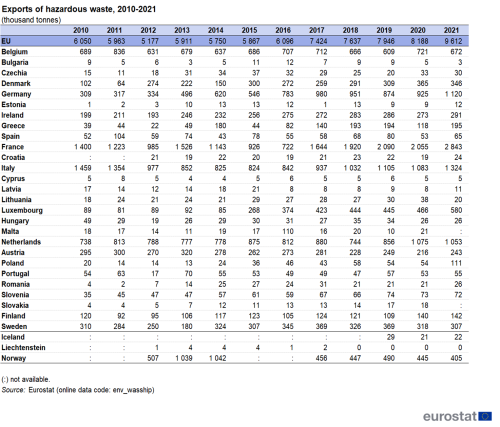Waste shipment statistics
Data extracted in July 2023
Planned article update: December 2024
Highlights
Between 2010 and 2021, exports of hazardous waste from EU Member States increased substantially, from 6.1 million tonnes to 9.6 million tonnes.
In 2021, 82.4 % of the hazardous waste exported by EU Member States was treated through recovery processes, 17.6 % by disposal.
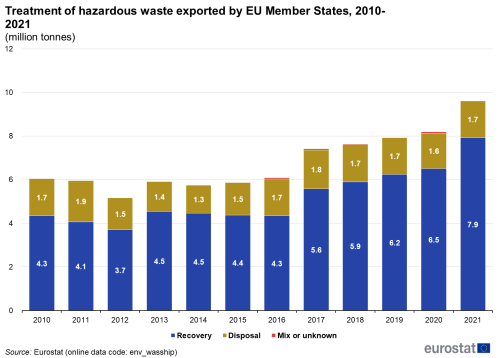
(million tonnes)
Source: Eurostat (env_wasship)
This article reports the hazardous and non-hazardous waste exported by EU Member States to other EU Member States and to countries outside the EU. The data are analysed by the type of waste, the main destinations, waste treatments in the destination, as well as the EU Member State with the highest exported quantity for each waste category. There is also a special section analysing exports of waste electrical and electronic equipment (WEEE) (also known as ‘e-waste’).
- The largest share of hazardous waste exported by the EU Member States is waste stemming from construction, civil engineering and demolition activities.
- Exports of hazardous waste from EU Member States has increased steadily in recent years, reaching close to 9.6 million tonnes in 2021.
- Landfilling (D1) of hazardous waste exported by EU Member States peaked at 698 000 tonnes in 2017, before falling to 576 000 tonnes in 2021.
- R4: Recycling/reclamation of metals and metal compounds as well as R5: Recycling/reclamation of other inorganic compounds dominate the treatment of exported hazardous waste. In particular, R5: Recycling/reclamation of other inorganic compounds increased by 234 % over the period from 2010 to 2021, plateauing at 1.8 million tonnes in 2021.
- EU Member States primarily export their hazardous waste to other Member States; between 2014 and 2020, this share has fluctuated between 91 % and 89 %. Since 2010, practically no exports of hazardous waste to non-OECD countries have been registered.
- In 2021, the EU Member States exported 125 451 tonnes of ‘Waste electrical and electronic equipment’ (WEEE) containing hazardous substances, but only 7 208 tonnes of non-hazardous WEEE.
Full article
Exports of hazardous waste – total quantities and per capita
Hazardous waste is waste which is harmful to humans or to the environment. Annex III of the Waste Framework Directive (Directive 2008/98/EC on waste) provides a list of properties which renders waste hazardous. This list includes properties such as the waste being explosive, oxidizing, flammable, irritant, harmful, toxic or releasing toxic gases when in contact with eater, air or an acid, corrosive, infectious, as well as waste which is capable of causing a hypersensitization reaction or may induce cancer, congenital malformations or hereditary genetic defects. It also includes waste that may present risks for one or more sectors of the environment.
Between 2010 and 2021, the amount of hazardous waste exported from EU Member States increased substantially, from 6.1 million tonnes in 2010 to 9.6 million tonnes in 2021. There was a sharp upturn in exports from 2016 to 2017, increasing by more than one fifth from 6.1 to 7.4 million tonnes (+22 %). In 2021, the EU Member States accounting for the highest quantities of exported hazardous waste were France (2.8 million tonnes), Italy (1.3 million tonnes, Germany and the Netherlands (both 1.1 million tonnes).
Overall, the EU exported 21.5 kg of hazardous waste per inhabitant in 2021, up from 18.3 kg per capita recorded in 2020. Luxembourg exported 913.1 kg of hazardous waste per inhabitant, of which 75 % (689 kg) were mineral mass wastes. This mineral waste mostly originated from construction and demolition activities. Relative to the number of inhabitants, such activities appeared to be more extensive in Luxembourg than in other Member States. Furthermore, the share of mineral wastes in total exports of hazardous waste was much higher than the European average of 23 %. Other EU Member States with notable exports of hazardous waste were Netherlands (60.2 kg), Denmark (59.3 kg), Ireland (58.2 kg) and Belgium (58.1 kg) (see Table 2). In 2021, 12 of the EU Member States exported less than 10 kg of hazardous waste per inhabitant.
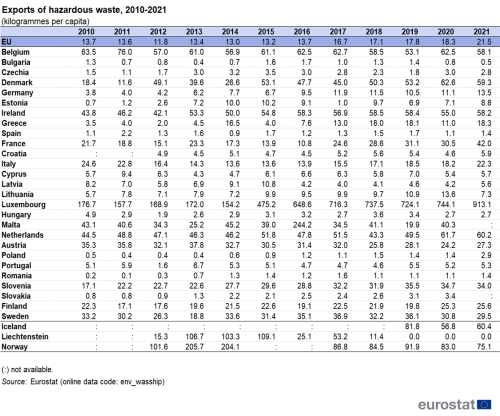
(kilogrammes per capita)
Source: Eurostat (env_wasship)
Exports of hazardous waste between EU Members States and out of the EU
In 2021, 8.8 million tonnes of hazardous waste were exported from one EU Member State to another (see Table 3), corresponding to approximately 91 % of the exports of hazardous waste.
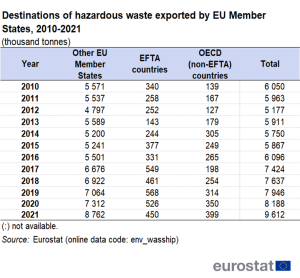
(thousand tonnes)
Source: Eurostat (env_wasship)
The exports of hazardous waste from the EU Member States to EFTA countries, chiefly Switzerland and Norway, fell to 450 000 tonnes in 2021. This corresponded to 4.7 % of the total export of such waste. The exports to other OECD countries, outside the EU and EFTA, amounted to 399 000 tonnes in 2021. This made up 4 % of the total. The main destinations among these countries were the United Kingdom and Türkiye.
Treatment of exported hazardous waste
The amount of hazardous waste exported from the EU Member States for disposal in the destination country was 1.7 million tonnes in 2021, same amount as in 2010 after a decreasing between 2011 and 2016. Over the same period, the amount exported for recovery increased from 4.3 million to 7.9 million tonnes.
Figure 1 shows the shares of the hazardous waste exported by the Member States for recovery or disposal in the destination countries. As a percentage of the total shipments, the share for recovery increased from 71.8 % in 2010 to a peak of 82.4 % in 2021. Correspondingly, the share for disposal decreased from 28.1 % to 17.6 % over the same period. The shares of shipments treated through recovery or disposal fluctuated throughout this period, with between 68.2 % and 82.4 % being recovered and between 17.6 % and 31.8 % being disposed. The treatment is unknown or a mix of recovery and disposal for only a marginal share of the exported hazardous waste, with a share well below 1 % in most years and exceeding it only in 2016 (1.2 %).
Please note that these trends do not represent the trends of hazardous waste recovery and disposal within the EU, as the amounts exported for treatment outside the EU are less than 10 % of the hazardous waste treated in each Member State (compare with Statistics explained article Waste statistics, Figure 7).
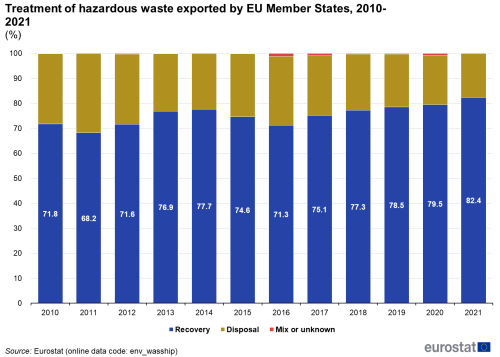
(%)
Source: Eurostat (env_wasship)
In 2021, the main treatment categories for exported hazardous waste were R5: recycling/reclamation of other inorganic materials (1.8 million tonnes) and R4: recycling/reclamation of metals and metal compounds (1.6 million tonnes) (see Figure 2).
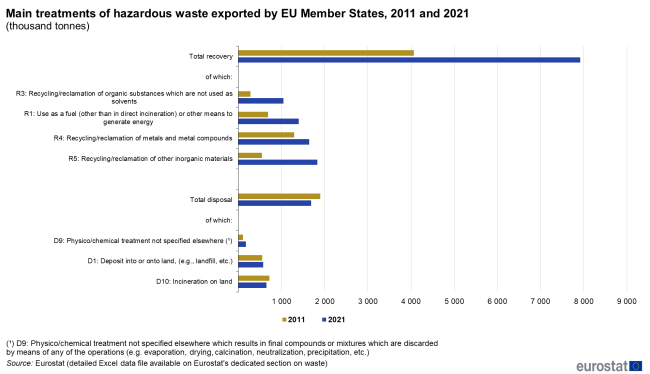
(thousand tonnes)
Source: Eurostat (detailed Excel data file available on Eurostat's dedicated section on waste)
In 2021, about 1.4 million tonnes of exported hazardous waste were incinerated with energy recovery (R1: Use as fuel) and 652 000 tonnes without energy recovery (D10:Incineration on land), together accounting for more than one fifth (21.3 %) of the total treatment of exported hazardous waste.
Among the disposal activities, D1: Deposit into or onto land (landfilling) of exported hazardous waste fell from 469 000 tonnes in 2010 to 576 000 tonnes in 2021. However, the amount fluctuated substantially within this period. From 2013 to 2017, landfilling grew continuously, peaking at 698 000 tonnes in 2017, before falling in 2019 and 2020 and increasing again in 2021.
Exports of hazardous waste for R4: Recycling/reclamation of metals and R5: Recycling/reclamation of other inorganic materials also increased since 2010. R4: Recycling and reclamation of metals increased from 1.3 million tonnes in 2010 to 1.6 million tonnes in 2021. The amount of R5: recycling/reclamation of other inorganic materials was 0.6 million tonnes in 2010, peaking at 1.8 million tonnes in 2021.
Waste shipment based on the European List of Waste (LoW) codes
A more detailed understanding of exports (‘transboundary waste shipments’) is possible by supplementing the information based on reporting under the Basel Convention presented above with the codes of the European List of Waste (LoW) classification about the types of waste crossing the borders.
It is possible to link waste identified by a European LoW code to the most common treatment for the waste exported, to identify the main EU Member States exporting the different waste categories and the main destination countries for these exports.
Hazardous waste — main treatment, exporting EU Member State and destination
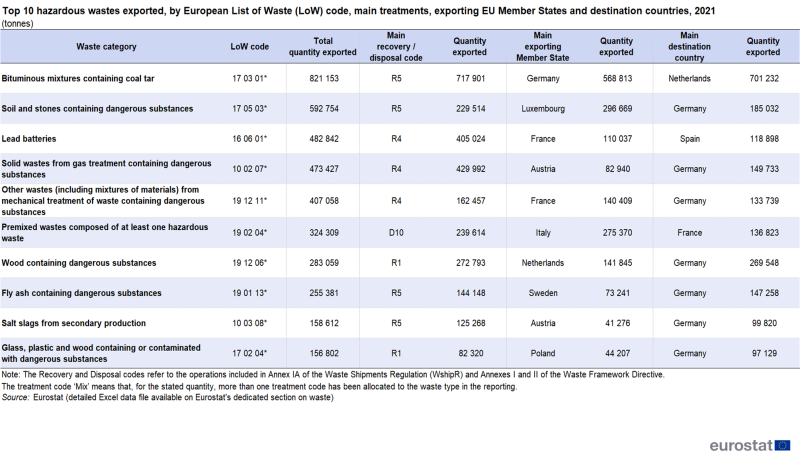
(tonnes)
Source: Eurostat (detailed Excel data file available on Eurostat's dedicated section on waste)
Table 4 shows that a large part of the exported hazardous waste comes from construction and demolition activities (LoW chapter 17) such as Bituminous mixtures containing coal tar (17 03 01*) and Soil and stones containing dangerous substances (17 05 03*).
Bituminous mixtures containing coal tar (17 03 01*) covers construction and demolition wastes, more specifically excavated roads, parking spaces and other tarred surfaces, etc. This is mainly treated through R5: Recycling/reclamation of other inorganic materials (87 % of the total exports of this waste category). The main source for export of this waste among the EU Member States was Germany, which accounted for 69 % of the total exported amount from the EU Member States in 2021. The waste was primarily transported to the Netherlands, which treated 85 % of the exported total.
In 2021, almost 39 % of the exported Soil and stones containing dangerous substances (17 05 03*) were treated by R5: Recycling/reclamation of other inorganic materials. Luxembourg, with 296 669 tonnes (50 % of the total), was the main exporting EU Member State. Germany was the main destination, receiving 185 032 tonnes of the exports from EU Member States (31 % of the total).
Waste from waste management facilities (LoW codes starting with 19) is also exported in high quantities. A large part of the waste residues from waste treatment (Basel code Y-18) comes from mechanical waste treatment (sorting, crushing etc.), including waste from LoW subchapter 19 12 which includes Wastes from mechanical treatment of waste containing dangerous substances (19 12 11*) and Wood containing dangerous substances (19 12 06*). Other important waste types from waste treatment facilities include Wastes from physico/chemical treatments (LoW subchapter 19 02), including Premixed wastes composed of at least one hazardous substance (19 02 04*) in the top 10 of hazardous wastes exported from the EU Member States in 2021, as well as Sludges from physico/chemical treatment containing dangerous substances (19 02 05*),Liquid combustible wastes containing dangerous substances (19 02 08*) and Oil and concentrates from separation (19 02 07*).
Solid wastes from gas treatment containing dangerous substances (10 02 07*) also appeared in the top 10 list in 2021. It refers primarily to the treatment of bottom ash from the iron and steel industry. This is almost exclusively treated in recycling operations for the R4: Recycling/reclamation of metals and metal compounds (91 % of the total exports of this waste category) found in this ash. The main source in the EU for this waste was Austria, accounting for 18 % of the total exported amount. The waste was primarily sent to Germany, which treated 32 % of the total.
Lead batteries (16 06 01*) are also exported in high quantities (third highest exported waste type).
Non-hazardous waste – main treatment, exporting EU Member State and destination
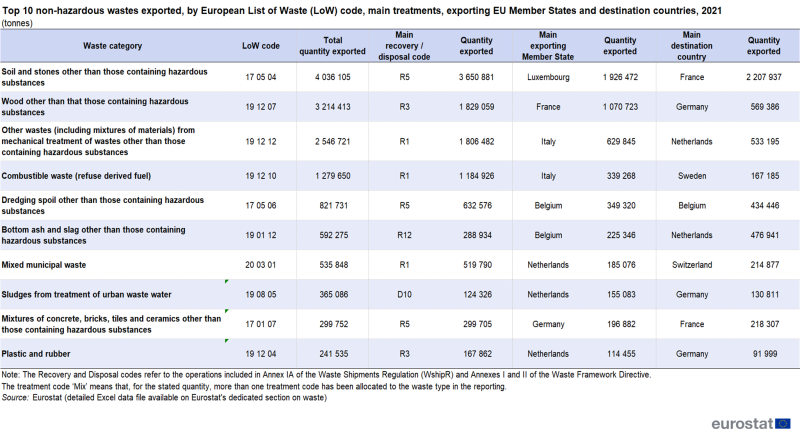
(tonnes)
Source: Eurostat (detailed Excel data file available on Eurostat's dedicated section on waste)
The EU Member States exported close to 15.0 million tonnes of non-hazardous wastes in 2021. Table 5 shows the top 10 non-hazardous waste types according to the European LoW. These 10 most exported waste categories added up to 13.9 million tonnes, corresponding to 84 % of the total exports of non-hazardous waste from EU Member States in 2021.
Construction and demolition activities (LoW chapter 17) accounted for a large share of the exports of non-hazardous waste (approximately 5.2 million tonnes, or 34 % of the total), with Soil and stones other than those containing hazardous substances (17 05 04) as the largest category in the list. This waste was primarily exported for R5: Recycling and reclamation of other inorganic materials, with a share of 90 % of the total exported quantity of this category. Luxembourg accounted for nearly one half (48 %) of the total exports of this waste category in 2021. France was the main destination, with 2.2 million tonnes (55 %).
Waste from waste treatment (LoW chapter 19) made up three of the four most exported waste categories at the top of the list in 2021. Of the 2.5 million tonnes of waste of Wood not containing hazardous substances (19 12 07), 57 % was for R3: Recycling or reclamation of organic substances. France was the main exporting Member State of this category (33 % of the total). The main destination for these exports of wood waste was Germany (18 % of the total).
More than 2.5 million tonnes of Other wastes (including mixtures of materials) from mechanical treatment of wastes, other than those containing hazardous substances (19 12 12) were exported from EU Member States in 2021. The main exporting Member State was Italy (25 % of the total), while the main destination was the Netherlands (21 % of the total). The main treatment, covering almost 71 % of the exported quantity, was R1: Use as fuel or to generate energy.
Waste of electrical and electronic equipment (WEEE)
In 2021, the EU Member States exported 118 243 tonnes of Waste of electrical and electronic equipment (WEEE) containing hazardous substances and 7 208 tonnes of non-hazardous WEEE. Table 6 shows the quantities of different types of hazardous and non-hazardous notified waste of electrical and electronic equipment exported in 2021.
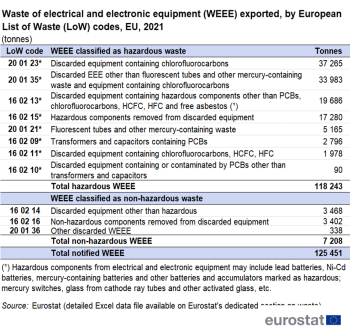
(tonnes)
Source: Eurostat (detailed Excel data file available on Eurostat's dedicated section on waste)
WEEE exported from EU Member States are mostly recovered. R4: Recycling/reclamation of metals and metal compounds and R5: Recycling/reclamation of other inorganic materials are the primary recovery operations.
Source data for tables and graphs
Data sources
The main source for this article is the data reported by EU Member States according to the Waste Shipment Regulation. In the EU, exports of waste are regulated by Regulation (EC) No 1013/2006 on shipments of waste, commonly referred to as the Waste Shipment Regulation (WShipR). It implements the Basel Convention, which bans exports of hazardous waste from OECD countries to non-OECD countries. According to the WShipR, all hazardous waste as well as some problematic waste streams and other wastes defined in the WShipR, must be notified to the authorities before being shipped across borders.
The Member States must report the precise treatment of the hazardous waste. The treatment of waste is broken down by recovery and disposal operations, as listed in Annexes I and II to the Waste Framework Directive (Directive 2008/98/EC on waste).
Information about notified shipped waste can be greatly enhanced when Member States also indicate the European List of Waste (LoW) in addition to the Basel codes. The main extra information relates to:
- the type of waste shipped across borders;
- the processes behind the generation of the wastes;
- special hazardousness or hazardous substances contained in the waste;
- possibilities for assessing required waste treatment capacities.
The shipment notification application form used in the EU is included as Annex VII of the WShipR. It asks for information on:
- Basel Y-codes according to Annexes I and II of the Basel Convention (47 different code numbers are available, 45 of which concern hazardous waste);
- detailed Basel codes according to Annexes VIII and IX of the Convention (120 code numbers are available, 60 of which concern hazardous waste);
- OECD codes (150 different code numbers are available, 60 of which concern hazardous waste);
- European List of Waste codes (842 code numbers are available, 408 of which concern hazardous waste).
The submitted data regarding transboundary shipments of waste covers both waste shipped out of and into the EU Member States.
Definitions
The term 'exports' is used for transboundary waste movements (‘shipments’) both within the EU and in particular for movements of waste to other OECD countries. Detailed information on exports of waste based on the European List of Waste (LoW) classification is also provided.
The recovery (R) and disposal (D) codes refer to the operations included in Annex IA of the Waste Shipment Regulation (WShipR) (Regulation (EC) No 1013/2006) and Annexes I and II of the Waste Framework Directive (WFD) (Directive 2008/98/EC).
Hazardous waste is waste which is harmful to humans or to the environment. Annex III of the Waste Framework Directive (Directive 2008/98/EC on waste) provides a list of properties which renders waste hazardous.
Waste from electrical and electronic equipment (WEEE) includes a large range of devices such as computers, fridges and mobile phones at the end of their life. This type of waste contains a complex mixture of materials, some of which are hazardous. These can cause major environmental and health problems if the discarded devices are not managed properly. In addition, modern electronics contain rare and expensive resources, which can be recycled and re-used if the waste is effectively managed. Shipments of WEEE cannot be identified under the Basel Y-codes, but different types of WEEE can be distinguished using the LoW codes, including hazardous WEEE and non-hazardous notified WEEE exports.
Context
According to the Waste Shipment Regulation (WShipR) (Regulation (EC) No 1013/2006), all hazardous waste as well as some problematic waste streams and other wastes defined by the WShipR, must be notified to the authorities before it is allowed to be shipped across national borders. Article 51(1) of the WShipR states that, before the end of each calendar year, each Member State shall send to the European Commission a copy of the report for the previous calendar year on the quantities of notified transboundary shipped waste and the quantity of hazardous waste generated which, in accordance with Article 13(3) of the Basel Convention, it has drawn up and submitted to the Convention Secretariat.
In November 2021, the European Commission presented a Proposal for a new Regulation on Shipments of Waste. In January 2023, the European Parliament adopted amendments on the Commission’s proposal.
In line with the objectives set out in the European Green Deal, the Circular Economy Action Plan and the review clauses in the Waste Framework Directive (WFD), in February 2022 launched an open consultation for revision of the Waste Framework Directive (WFD). The aim was to gather evidence to improve the overall environmental outcome of waste management in line with the waste hierarchy and the implementation of the polluter pays principle.
Eurostat publishes data and analysis on transboundary waste shipments in the European Union (EU) since 2011. The data and analysis cover various aspects of waste shipments, generally on an aggregated level.
The quantity of waste electrical and electronic equipment (widely known as WEEE or e-waste) generated every year in the EU is increasing rapidly. It is now one of the fastest growing waste streams. The EU has introduced the Waste Electrical and Electronic Equipment Directive (WEEE Directive) and the Restriction of the use of certain Hazardous Substances in Electrical and Electronic Equipment Directive (RoHS Directive) to tackle the issue of the growing amount of WEEE.
Direct access to
Other articles
- Waste (env_was), see:
- Waste streams (env_wasst)
- Transboundary shipments of notified waste by partner, hazardousness and waste management operations (env_wasship)
- Waste streams (env_wasst)
- European Commission - DG Environment – Report from the Commission on the implementation of Regulation (EC) No 1013/2006 on shipments of waste: Generation, treatment and transboundary shipment of hazardous waste and other waste in the Member States of the European Union, 2013-2015 (COM(2018) 762 final)
- Annex to this report: Part 1 and Part 2 of Commission staff working document SWD(2018) 468 final (22 November 2018)
- European Commission - DG Environment – Proposal for a new Regulation on Waste Shipments (17 November 2021)
- European Commission - DG Environment - Repository of Commission reports on waste shipments
- European Environment Agency
- Resource efficiency and waste
- Movements of waste across the EU`s internal and external borders (EEA Report No 7/2012)
- Material resources and waste (State of the environment report No 5/2010)
- Waste without borders in the EU? (EEA Report No 1/2009)
